© 2014-


Almost There ! (4)
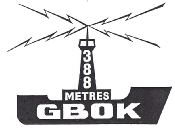
GBOK
Secondly came Canadian, Arnold Swanson, who had been technical adviser to the Voice of Slough project. After splitting from the Voice of Slough project Swanson announced in 1962 even more elaborate plans to launch a station -
The Amalgamated Broadcasting Company was formed to front the project with r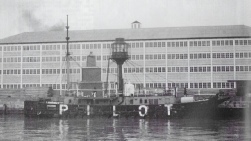 egistered offices and studios at Swanson's home, Notley Abbey, Thame, Buckinghamshire. A London office for the Amalgamated Broadcasting Co. was also established at 151 Fleet Street, EC4, but commercial airtime on the planned station was to be sold through another company, Adanac Broadcasting Agency, which also operated from the same two addresses.
egistered offices and studios at Swanson's home, Notley Abbey, Thame, Buckinghamshire. A London office for the Amalgamated Broadcasting Co. was also established at 151 Fleet Street, EC4, but commercial airtime on the planned station was to be sold through another company, Adanac Broadcasting Agency, which also operated from the same two addresses.
Announcer Ed Moreno (who was later to work for several offshore radio stations) spent four days a week for several months recording GBOK programmes at the Notley Abbey studios, which had been built by Roy Barrett (who had also previously been involved with the Voice of Slough project). Two ‘retired’ BBC engineers -
First actual press repor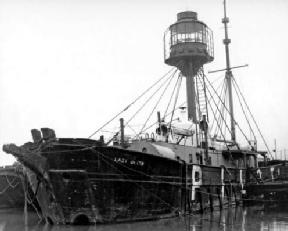 ts of GBOK appeared in the Southend Standard on 15th February 1962, indicating that the station would be broadcasting music, features and advertising 24 hours a day from a former lightship anchored near The Nore, the same location as had been planned for the Voice of Slough's broadcasting vessel, starting on 28th February 1962.
ts of GBOK appeared in the Southend Standard on 15th February 1962, indicating that the station would be broadcasting music, features and advertising 24 hours a day from a former lightship anchored near The Nore, the same location as had been planned for the Voice of Slough's broadcasting vessel, starting on 28th February 1962.
The station planned to broadcast on 773kHz (388m) using a 5Kw Marconi transmitter and hoped to reach a potential audience of 11 million listeners within a 150 mile radius covering the south east and Midlands. Places as far away as Nottingham, Leicester, Coventry, Birmingham and Bristol were planned to be within the station's primary coverage area and a "bonus French audience" across the English Channel was also offered for the benefit of advertisers.
GBOK was promoted in a glossy 12 page brochure which attempted to explain in some detail to listeners and potential advertisers (who were accustomed only to the BBC's style of programming) just how a 24 hour American format music station would sound. (See Interactive Zone, right) Programme Director for GBOK was Roy Dunlop.
Programmes were to be of popular music with five minute news broadcasts on the hour every hour a completely new experience for British listeners who were used to the BBC's diet of early morning, lunchtime and evening set piece news bulletins. GBOK planned to make the claim "First with the Important News" for this service.
After the early morning "Wake-
According to the sta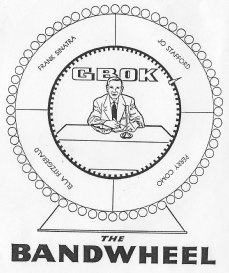 tion's promotional literature the Bandwheel was an actual wheel, 9' in diameter with room in the centre for the announcer's desk and microphone. The wheel was divided into quarters, each allocated to particular artists or performers which were changed regularly throughout the day. An inner circle on the wheel was divided into thirty three 15 minute segments and eleven 10 minute segments -
tion's promotional literature the Bandwheel was an actual wheel, 9' in diameter with room in the centre for the announcer's desk and microphone. The wheel was divided into quarters, each allocated to particular artists or performers which were changed regularly throughout the day. An inner circle on the wheel was divided into thirty three 15 minute segments and eleven 10 minute segments -
These segments were available for sponsors to purchase and the announcer would then mention their name and product frequently during that part of the programme.
In association with the "Bandwheel" programme the station also planned to run a Jackpot Competition for listeners to predict (from a list printed on an entry form) which artists would perform in each of the 44 daily segments for the forthcoming two weeks! Entry forms were to be distributed through sponsors' retail outlets and Jackpot winners would be drawn by the announcer in the middle of each 10 or 15 minute segment.
Between the hours of 10.00pm and 6.30am GBOK planned the "All Night Dance Party", with sponsors being sought for each hourly segment or even the complete night's programme. Prime time advertising rates ranged from £16 for 20 seconds to £90 for a 15 minute segment, with discounts for multiple bookings. Sponsorship of the nightly "Dance Party" was to be by negotiation while newscasts could also be sponsored at the 5 minute rate plus a 33% premium. By March 1962 Arnold Swanson was claiming to have already sold enough airtime to finance a complete year's programming on GBOK.
Lady Dixon
Photo: Paul Graham












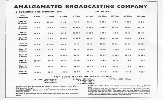

Click images to enlarge




Ground
Floor
Back to




State Monopolies and International Agreements









Back to Gallery index

Almost There ! (5)

The Guardian
00 February 1962

Daily Telegraph
19th February 1962

Sunday Times
00 February 1962

Click images to enlarge
Lady Dixon in her days as a pilot vessel
